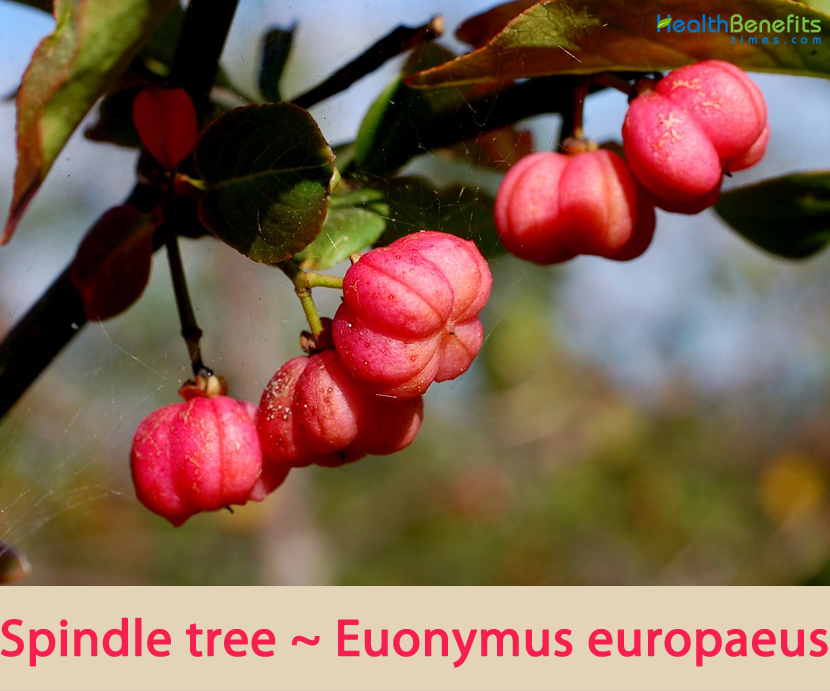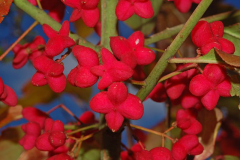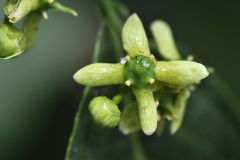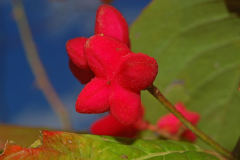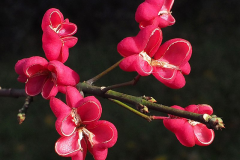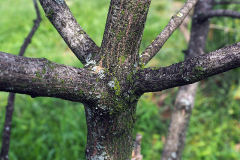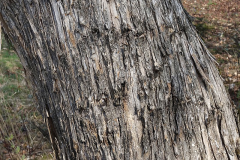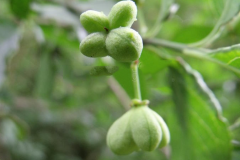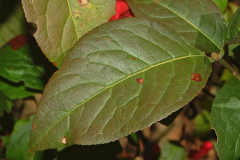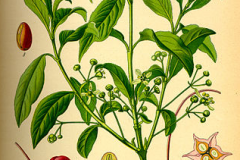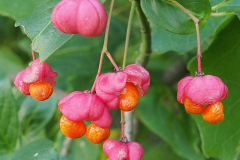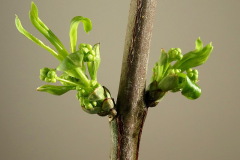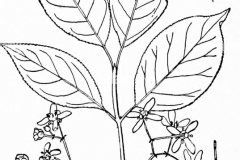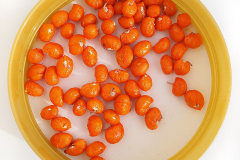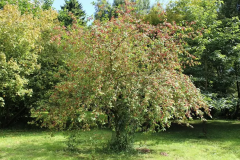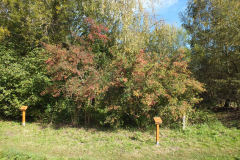| Spindle tree Quick Facts | |
|---|---|
| Name: | Spindle tree |
| Scientific Name: | Euonymus europaeus |
| Origin | Throughout Europe and southeastern Asia |
| Colors | Initially green turning to dark pink or red when mature |
| Shapes | Dehiscent capsules are 1-1.5 cm wide, with 4 angled lobes |
| Taste | Sweetish, bitter and acrid |
| Health benefits | Support for stimulating appetite, liver disorders, treat scabies, lice (head, body or pubic), ticks and other skin parasites |
| Name | Spindle tree |
|---|---|
| Scientific Name | Euonymus europaeus |
| Native | Throughout Europe and southeastern Asia |
| Common Names | European spindletree, Common spindle, Spindle, Skewer wood, Spindletree, European euonymus, European spindle-tree, Spindle-Tree, Broad-leaved Spindle, prickwood, Skewerwood, Gatter, Gatten, Gadrose, Pigwood, Dogwood, Indian Arrowroot, Burning Bush, Wahoo |
| Name in Other Languages | Albanian: Herdhaqeni i Evropës, shikakuq Aragonese: Bonetero, modrollonera Basque: Basa erramua Bulgarian: Evropeĭski chashkodryan (европейски чашкодрян), rŭbest chashkodryan (ръбест чашкодрян) Catalan: Barretets de capellà, bonnets, evònim, evónim europeo Chinese: Ōuzhōu wèi máo (欧洲卫矛) Croatian: Obična kurika Czech: Brslen evropský Danish: Almindelig benved, Benved Dutch: Wilde kardinaalsmuts, Brede kardinaalsmuts English: European spindletree, Common spindle, Spindle, Skewer wood, Spindletree, European euonymus, European spindle-tree, Spindle-Tree, Broad-leaved Spindle, prickwood Estonian: Harilik kikkapuu Finnish: Euroopansorvarinpensas French: Bonnet de prêtre, Fusain d’Europe, Fusain deurope, Fusain à larges feuilles, bois à lardoires, bois-carré, bonnet carré, bonnet d’évêque, cherme, chermine, garais Galician: Boneteiro German: Gemeines Pfaffenhütchen, Gewöhnliches Pfaffenhütchen, Pfaffenhütchen, Breitblättriges Pfaffenhütchen, europäischer Spindelstrauch, europäisches Pfaffenhütchen, europäisches Pfaffenhütlein, gemeines Pfaffenhütchen, gewöhnlicher Spindelstrauch, Pfaffenhütchen, Spindelstrauch Hungarian: Csíkos kecskerágó, berretta da prete, berretta di prete, cappet da prete, coralline, evonimo europeo, fusaggine commune, fusaria, fusaria commune Italian: Fusaggine maggiore Latvian: Eiropas segliņš Lithuanian: Europinis ožekšnis Norwegian: Spolebusk Occitan: Aubieque, bounet de cure, bounét de caperâ, huch-pudent, hurdù Polish: Trzmielina pospolita, trzmielina zwyczajna Portuguese: Barrete-de-padre, bonete-de-crego, evónimo Romanian: Salbă-moale Russian: Beresklet evropejskij, beresklet yevropeyskiy (бересклет европейский), bruslina (бруслина) Serbian: Kurtka (курика), mašljika (машљика) Slovak: Bršlen európsky , bršlen obyčajný Slovene: Navadna trdoleska Spanish: Boj montés, bonetero, bonetillo, evónimo, falso boj, husera, modrollonera, monetillo, palo de cuatro carretas Swedish: Benved, Euroopansorvarinpensas Turkish: Açık köklü, iğcik ağacı Ukrainian: Bruslyna chernyayeva (бруслина черняєва), bruslyna yevropeysʹka (бруслина європейська) Welsh: Llwyn Addurnol, Pisgwydden, Piswydd, Piswydden, Pren Cas Gan Gythraul, Pren Clefyd Melyn |
| Plant Growth Habit | Large, much-branched, non-spiny, twiggy upright spreading, deciduous, glabrous or minutely hairy shrub or small tree |
| Growing Climates | Forests, scrub, hedges, gentle slopes, in man-made or disturbed habitats, floodplains, forest margins, shrub lands, thickets, clearings, mixed broadleaved oak-hornbeam forests and open woodlands preferring medium moisture levels |
| Soil | Easily grown in average, medium moisture, well-drained soil in full sun to part shade. It tolerates a wide range of soils except for wet, poorly-drained ones. Prefers alkaline soils. Plants appreciate consistent and even moisture, particularly when grown in full sun locations |
| Plant Size | Grows to 3–6 m (10–20 ft.) tall, rarely 10 m (33 ft.), with a stem up to 20 cm (8 in) in diameter |
| Bark | Thin, greenish-brown to reddish brown, shallow longitudinal splits; becoming irregularly shreddy-ridged with age |
| Twigs | Twigs green, 4-angled, branches at almost right angles to shoot |
| Leaf | Opposite, elliptical or oblong-lanceolate to ovate-lanceolate, acute or acuminate, entire or crenate-serrulate, base cuneate. They are 3–10 cm long and 1.5–4-cm wide. The leaf margins are crenate and finely saw-toothed and the leaves are glabrous, dark green color above and paler, and possibly pubescent below |
| Flowering season | May to June |
| Flower | Flowers occurs in 3 to 10 flowered, dichotomous axillary, pedunculate cymes, glabrous, 8–10 mm diameter, usually four-merous, parts borne around a broad green nectary. Petals are thicker than the sepals, greenish, oblong and widely separated and the ventral surface is papillate |
| Fruit Shape & Size | Dehiscent capsules are 1-1.5 cm wide, with 4 angled lobes |
| Fruit Color | Initially green turning to dark pink or red when mature |
| Seed | Ruddy-orange-coloured seeds covered by a fleshy red-orange layer (pseudo-aril) |
| Flavor/Aroma | Very faint, characteristic odor, resembling liquorice |
| Taste | Sweetish, bitter and acrid |
| Plant Parts Used | Bark, root, leaves, fruit, seeds, whole plant |
| Propagation | By cuttings or by Seed |
| Lifespan | May live for well over 100 years. |
| Season | September to November |
| Culinary Uses | An edible yellow dye is obtained from the fruit and seed. |
Plant Description
Spindle tree is a large, much-branched, non-spiny, twiggy upright spreading, deciduous, glabrous or minutely hairy shrub or small tree that normally grows about 3–6 m (10–20 ft.) tall, rarely 10 m (33 ft.), with a stem up to 20 cm (8 in) in diameter. The plant is narrow and upright when young, rounding and broadening with age. The plant is found growing in forests, scrub, hedges, gentle slopes, in man-made or disturbed habitats, floodplains, forest margins, shrub lands, thickets, clearings, mixed broadleaved oak-hornbeam forests and open woodlands preferring medium moisture levels. The plant is easily grown in average, medium moisture, well-drained soil in full sun to part shade. It tolerates a wide range of soils except for wet, poorly-drained ones. It prefers alkaline soils. Plants appreciate consistent and even moisture, particularly when grown in full sun locations.
Stem & Bark
The bark is smooth, thin, greenish-brown to reddish brown, shallow longitudinal splits; becoming irregularly shreddy-ridged with age. Twigs are slender, green turning brown with age, may be 4 sided, leaf scars are light brown and obvious against green twig; buds are green and sharp pointed. New shoots grow vigorously, also 4-angled and winged. The buds are 2-4 mm long, ovoid, sharply pointed. The young branches are characteristically quadrangular and have the clear green dotted bark.
Leaves
The leaves are opposite, elliptical or oblong-lanceolate to ovate-lanceolate, acute or acuminate, entire or crenate-serrulate, base cuneate. They are 3–10 cm long and 1.5–4-cm wide. The leaf margins are crenate and finely saw-toothed and the leaves are glabrous, dark green color above and paler, and possibly pubescent below. Petiole is 6–12 mm long grooved along the top. Leaves are dark green in summer. Autumn color ranges from yellow-green to reddish-purple, depending on environmental conditions.
Flower
This species is gyno-dioecious, having female flowers on some individual plants and hermaphrodite flowers on others. Flowers occurs in 3 to 10 flowered, dichotomous axillary, pedunculate cymes, glabrous, 8–10 mm diameter, usually four-merous, parts borne around a broad green nectary. Petals are thicker than the sepals, greenish, oblong and widely separated and the ventral surface is papillate. Ovary is partially inferior, placentation axile, the stigmatic lobes opening like a mouth as they become receptive. Stamens partially fused with the ovary wall. The flowers are produced in April-July and are insect-pollinated.
Fruit
Fertile flowers are followed by fruits which are extremely showy. Dehiscent capsules are 1-1.5 cm wide, with 4 angled lobes. Fruits are initially green turning to dark pink or red when mature. Ripe capsules split open through 4 valves, revealing 4 ruddy-orange-coloured seeds covered by a fleshy red-orange layer (pseudo-aril). Seed mass with arils are 80–130 mg; without arils are 41–52 mg. Fruits ripen in September-October.
Seeds are attractive to certain birds that eat and distribute them. The berries attract children, but are harmful, for they are strongly emetic and purgative: they have proved fatal to sheep. The bark leaves and fruit are all injurious, and no animal but the goat will browse upon them.
Origin and characteristics
Spindle trees can be found throughout the entire northern hemisphere, but mostly in East Asia. However, there are also spindle species that are native to Europe such as Euonymus europaeus – the European spindle or common spindle. Spindles bear striking and colorful capsular fruits. When the fruit ripens, the four lobes split open revealing orange seeds. Depending on the type of spindle tree, the capsules can take on a brown or grey color. The spindle may also be referred to as spindle bush, which is actually more accurate of the plant’s shape and growth. Spindles can reach a maximum height of five meters and have a rather shrubby form. They are densely branched with a full-bodied crown. Many species feature square stems. There are deciduous and evergreen types of spindle trees. The latter ones often display gold or white leaves in autumn, whereas deciduous spindle trees turn red.
Popular spindle tree species
There are about 170 known spindle species at present. Most of them are of Southeast Asian origin, some even come from the Himalayas. There are three deciduous spindle species that are native to Central Europe.
Japanese spindle (Euonymus japonicus)
The Japanese spindle tree, or evergreen spindle, comes from Asia and can grow several meters tall if conditions are favorable. However, this species is not winter hardy and must therefore be kept in a pot, where it remains somewhat smaller. The leaves are about 5 cm in size and can take on an array of different colors, depending on the variety.
Winter creeper (Euonymus fortunei)
The winter creeper, also known as Fortune’s spindle, is an evergreen spindle tree. As its name suggests, the plant does not grow upright, but creeps or climbs on the ground. It is thus an ideal ground cover for garden beds or for creating green walls. This spindle species is often used for graves or small hedges, because it is so low-maintenance. Winter creepers are winter hardy to temperatures of about -20 °C, even though they are not native to Europe.
European spindle (Euonymus europaeus)
The European spindle is for obvious reasons the most common species in Europe, therefore also called common spindle. The shrub grows densely branched and upright. Its leaves turn a deep red in autumn. In winter, the European spindle tree bears striking, colorful fruits.
Broadleaf spindle (Euonymus latifolius)
Broadleaf spindle trees are very similar to the European type except for the leaves which are a bit broader. They are native to Europe but can only be found in the Alps and Alpine foothills.
Winged spindle (Euonymus alatus)
The winter hardy winged spindle originates from Japan and China. Due to its intense red coloring in autumn, it is also referred to as “the burning bush”. This species grows about 2 to 3 meters tall and wide. The branches bear corky ridges, reminiscent of wings, which are especially striking in the winter.
Dingle-dangle tree (Euonymus planipes)
This spindle species originally comes from Asia. It can reach a height of up to 3 and 5 meters and is often grown as an ornamental shrub. Its winter buds are rather large, pointed and of a striking purple-red color.
Traditional uses and benefits of Spindle Tree
- Bark is alterative, cholagogue, hepatic, laxative, stimulant and tonic.
- Root bark is the part normally used, though bark from the stems is sometimes used as a substitute.
- In small doses it stimulates the appetite; in larger doses it irritates the intestines.
- The bark is especially useful in the treatment of liver disorders which follow or accompany fevers.
- The seeds are strongly emetic and purgative.
- The fresh leaves, and the dried fruit and seeds, are used externally to treat scabies, lice (head, body or pubic), ticks and other skin parasites.
- It consists of a resin called euonymin, which stimulates appetite and the liver.
- Baked fruits were powdered and rubbed into hair as a remedy for head lice.
- In small doses, Euonymin stimulates the appetite and the flow of the gastric juice.
Other Facts
- The whole plant yields a volatile oil that is used in soap making.
- The oil is obtained from the seed.
- It is possible that there are two oils, an essential oil from the plant and oil from the seed.
- Good yellow dye is obtained from the fleshy coating around the seeds.
- This becomes green with the addition of alum, but unfortunately both colors are rather fugitive.
- Baked and powdered berries are used to remove lice from the hair; they are also used as an insecticide.
- Roots yield up to 4% gutta-percha, a non-elastic rubber used as an electrical insulation and for making plastics.
- A high quality charcoal is obtained from the wood, it is used by artists.
- It is a popular ornamental plant in gardens and parks due to its bright pink or purple fruits and attractive autumn coloring.
- In cultivation in the UK, the cultivar ‘Red Cascade’ has gained the Royal Horticultural Society’s Award of Garden Merit.
- European spindle wood is very hard, and can be cut to a sharp point; it was used in the past for making spindles for wool-spinning, for butchers’ skewers, knitting needles, toothpicks, carving etc.
- The plant can be used as part of an informal mixed hedge.
- It is planted in France for stabilizing sand dunes.
- The baked and powdered berries are used to remove lice from the hair; they are also used as an insecticide.
- Roots yield up to 4% gutta-percha, a non-elastic rubber used as electrical insulation and for making plastics.
- It is used, more in the past, for plywood, combs, and for making spindles, from which the common name derives.
- Decoction of the fruit has been used to treat mange in horses and cattle.
- The wood is also heat resistant and it was used in making tobacco-pipes.
- Charcoal from its wood is used for drawing, and to make charcoal powder.
- The red pseudo-aril was also used in the past to make dyes.
- The gypsies used wood instead to obtain sewing needles and crutches.
- Spindle timber is creamy white, hard and very dense; ideal for making small delicate items.
- In the past it was used to make ‘spindles’ for spinning and holding wool.
- The flowers of spindle are rich in nectar and an important food source for hoverflies, bees and other insects.
Precautions
- Fruit is poisonous, containing, amongst other substances, the alkaloids theobromine and caffeine, as well as an extremely bitter terpene.
- Poisonings are more common in young children, who are enticed by the brightly coloured fruits.
- Ingestion can result in liver and kidney damage and even death.
- Leaves and fruit can cause various symptoms of poisoning.
- Fruits contain harmful glycosides and alkaloids, which lead to vomiting as well as diarrhea when consumed.
- If the dose is too high, they can cause cramps, collapse and even death. However, these symptoms occur only twelve hours after consumption.
References:
https://www.itis.gov/servlet/SingleRpt/SingleRpt?search_topic=TSN&search_value=27949#null
https://npgsweb.ars-grin.gov/gringlobal/taxon/taxonomydetail?id=16258
https://pfaf.org/user/Plant.aspx?LatinName=Euonymus+europaeus
https://www.missouribotanicalgarden.org/PlantFinder/PlantFinderDetails.aspx?taxonid=279118
https://botanical.com/botanical/mgmh/s/spindl82.html
http://www.theplantlist.org/tpl1.1/record/kew-2803293
http://www.hplism.nic.in/sites/default/files/euonymus_europaeus.pdf
https://en.wikipedia.org/wiki/Euonymus_europaeus
https://gd.eppo.int/taxon/EUOEU
https://grinczech.vurv.cz/gringlobal/taxon/taxonomydetail.aspx?id=16258
http://temperate.theferns.info/plant/Euonymus+europaeus
https://www.cabi.org/isc/datasheet/23202
https://www.wikidata.org/wiki/Q161379
https://plants.usda.gov/home/plantProfile?symbol=EUEU7


